Leadership teams are a key asset of any organization. They formulate the company’s vision, align the entire staff under the same goal and move the organization’s strategy forward. At the same time, many leaders are struggling with balancing their core duties and the responsibilities they have as a part of a leadership team.
In this article, we will go through the ways you can increase the effectiveness of your leadership team with Microsoft Teams.
Collaboration challenges of leadership teams
Together as a team, leaders have a considerable impact on the entire organization. At the same time, their collective effectiveness oftentimes leaves room for improvement as they struggle with multiple collaboration challenges. There are, however, various tools at place these days that can help address them. But first let´s see what those challenges are.
Balancing responsibilities
One of the key challengers that senior managers face is actively collaborating with other leaders while keeping their functional duties. Finding the right balance and making sure everyone is equally invested in their leadership team responsibilities is crucial for addressing this issue. This can be achieved by encouraging transparency and open discussions about individual and team’s priorities.
Employee connection
Maintaining a trusting relationship and strong connection among team members is each leader’s responsibility. It is key to keeping the staff motivated and increasing overall organizational productivity. However, in today’s world of work where most organizations are operating remotely keeping employees connected has become a challenge. Leaders need to resort to digital collaboration tools and think outside the box to maintain team spirit even when their team members are miles apart.
Keeping everyone engaged
The key to success of a leadership team is equal participation of all the parties involved. If some of your leaders are not as committed and engaged in collaborating with other executives, the whole team effectiveness will be inevitably affected.
It is important to make sure everyone in the executive teams is communicating openly and contributing to achieving organization-wide goals.
The variety of leadership teams
To ensure your leaders stay connected both with their employees and fellow executives, it is worth considering what type of teams will require their participation.
Depending on the size and function of your organization, it’s worth considering creating the following teams:
- An org-wide team – to communicate important news and announcements with the entire staff.
Note, however, that the maximum limit for an org-wide team is 10,000 members.
- Country team
- Region team
- Team per office
- Team per department
- Leadership team
- Project team
For some organization it would make sense to combine some of the previously mentioned teams, such as country and region, office, and department. This way, you make sure you’re not overwhelmed with the number of teams you’re a member of and can process their content easier.
Microsoft Teams tools for leadership teams
Microsoft Teams offers various capabilities that encourage open communication and effective collaboration, increasing effectiveness of your leadership team and the organization as a whole.
Guide conversations with channels
You may want to equip your teams with channels that will serve as spaces for focused discussions. Make sure to include channels that will encourage communication, knowledge and idea sharing, and active participation in the life of the team. For example, you can create Inspiration channel where everyone could share their thoughts and ideas, interesting resources, and inspirational content. Fun channel can be a great space for sharing internal jokes, have informal meetings and discussions, quizzes, and virtual coffee breaks. It’s also worth creating Questions channel to foster open discussion and problem solving as a team.
Foster connection with Microsoft Teams meetings
With the swift shift to remote working, virtual meetings have become an indispensable part of our everyday life. Meetings help us stay connected and create a bond among team members. So, consider scheduling recurring meetings with your leadership team to share daily/weekly plans and always stay on top of things.
To make Microsoft Teams meetings more productive, you can use screensharing capability as share presentation decks as if you were presenting in real-life. Also, consider enabling together mode to break the ice and set a more interactive tone of the meeting.

You may also want to use apps during meetings in Microsoft Teams to note key ideas and encourage everyone’s active participation. Thus, with Whiteboard all meeting participants can draw, sketch, add notes, and then share results in a channel.
There’s also a capability to record meetings and share transcripts with users through Teams chats and channels.
Collaborate on files in real time
With Microsoft Teams you can store, share, and work on files with your colleagues right in the Teams environment. You may share files by posting a link in a relevant channel or by pinning the most important ones as tabs.
For example, if for each leadership briefing your team prepare a deck, you may ask everyone to work together on it by adding a slide with key information from each team member. You can easily track all the changes, leave comments and chat right in the shared file.
Host live events
You can still organize organization-wide events even if you’re operating remotely with Microsoft Teams live events. For example, you can host virtual training sessions, internal org-wide meetings and conferences, events dedicated to an important announcement, etc.
Live events support Q&A sessions where attendees can interact with speakers and participate in discussion through Q&A feed.
Currently Teams live events support up to 10,000 attendees. Starting from the end of June, the number will double!
Use native integrations
In Microsoft Teams you can integrate any Office 365 app to work on it directly in the Teams environment. This way, you and your leadership team will have all the necessary tools at place without the need to juggle between multiple apps.
OneNote
OneNote is an excellent tool that allows you to organize and structure information and easily share it with team members. You can use one note to share agenda before meetings and final notes afterwards.
You can pin it as a tab in dedicated channels for best practice sharing, for planning daily/weekly/monthly tasks and reminders.
Ask you fellow leaders to share all the pain points they want to address at the next meeting through OneNote and note down ideas and decisions made during meetings. This way you’ll make sure all key issues are addressed accordingly and necessary actions will be set to resolve them.
Yammer communities
If you work for a large enterprise, chances are you use Yammer to connect employees across the organization. Add relevant Yammer communities, such as CEO connection, as tabs in the right channel of your leadership team and use it to communicate with your employees on important company news and announcements. Regular communication and transparency are key to increasing the sense of unity and belonging among the employees.
Planner
To make sure all collective decisions are implemented, and nothing is left behind, you can resort to Planner. It’s a task management tool that allows you to create tasks, separate them into distinct categories, add attachments and links, create checklists, leave notes, set priority levels and deadlines.
You can assign tasks to various people and then track their progress. Planner can help better balance different responsibilities that leaders have by prioritizing their tasks accordingly.
Scaling leadership teams across the organization with Microsoft Teams templates
As we previously discussed, leaders’ participation may be required in a variety of teams within the organization, depending on its size and function. For example, in large companies with offices in different cities, regions and countries it will make sense to create according teams. Similarly, you will require leadership teams that will unite senior managers of each unit.
Let’s imagine you have offices in different location, for example in France, US, Germany, and Singapore. You may want to unite your business leaders in each country in separate teams to coordinate their activities.
To keep these teams organized and make sure they follow a similar structure, naming rules and other governance policies you can leverage Microsoft Teams Collaboration templates. This way, you will have a template with pre-built channels that correspond to all key topics of leaders’ discussions, all the required content already included such as key documentation and tabs with frequently used apps, and all the governance policies for teams already pre-set.
Let’s have a closer look at this example and build a template for a leadership team per country.
Channels
To build your template, you will first need to create a team you will base it on. Let’s call it Leadership – Template.
Add channels that will correspond to each topic your leadership teams discuss. For instance:
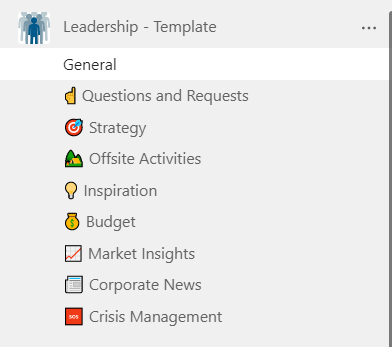
- Strategy
- Budget
- Corporate news
- Market insights
- Crisis management
- Inspiration
- Offsite activities
- Questions and requests
Tailor your channels according to your organizational needs.
Files and tabs
You can upload documentation and other files that you want to be shared with all the leadership teams across the organization. That can be corporate strategy, vision and mission, corporate goals, and other corporate documentation.
Additionally, you can create and configure apps that leaders may find useful for collaboration. For example, you can add Planner to create tasks, Forms to gather feedback and opinion, OneNote to mark down meeting agendas and share best practices and experience, Yammer for staying connected with the entire staff and other apps.
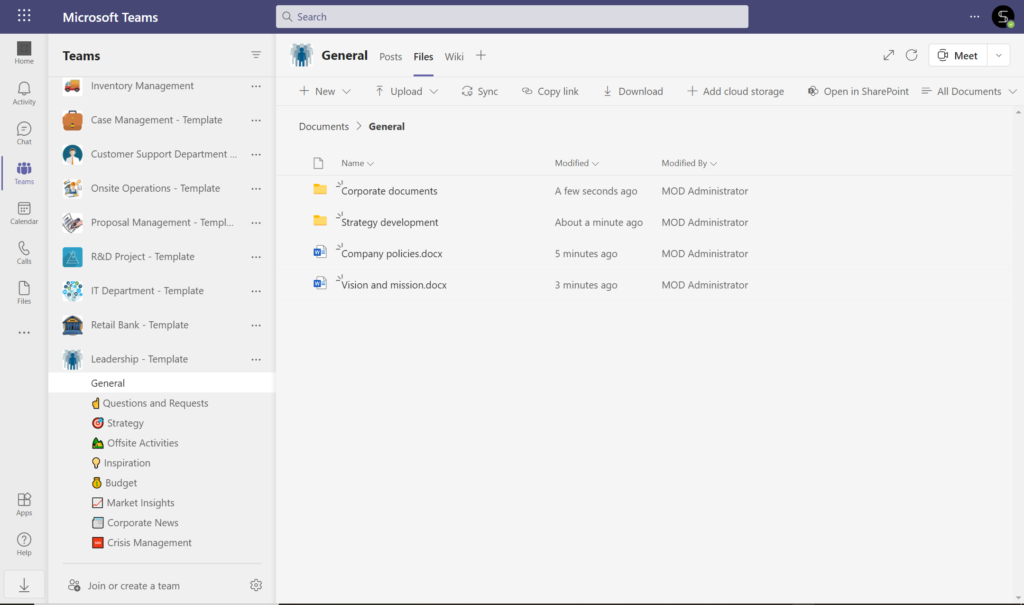
Governance policies
After you create your original team and add all the needed content, you can head over to the SalesTim tab and start creating your template. You can download the app here.
To build your template, by clicking on +New template in the Catalog tab and selecting your original team. Note that it’s available only for admins and catalog managers.
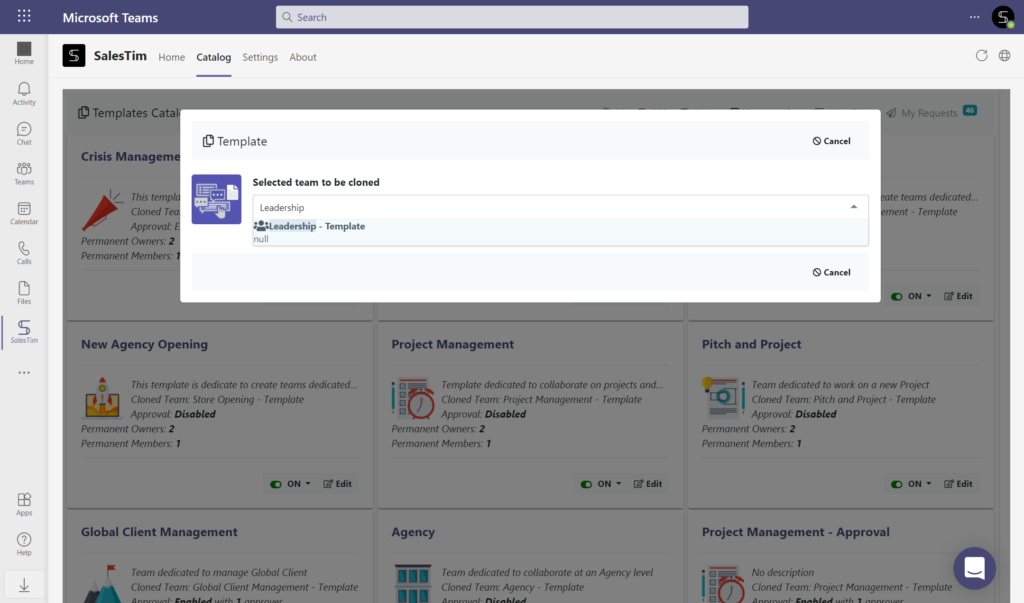
Then, you’ll be asked to configure governance policies.
You can set up a Naming convention for your leadership teams to make sure they follow the same naming structure. You can use both static and dynamic attributes from Azure AD for your naming policies.
For example, that can be: Leadership – User country
This way, when you create a new team from the template, it will be called according to the location of the team requestor: Leadership – USA, Leadership – Singapore, etc.
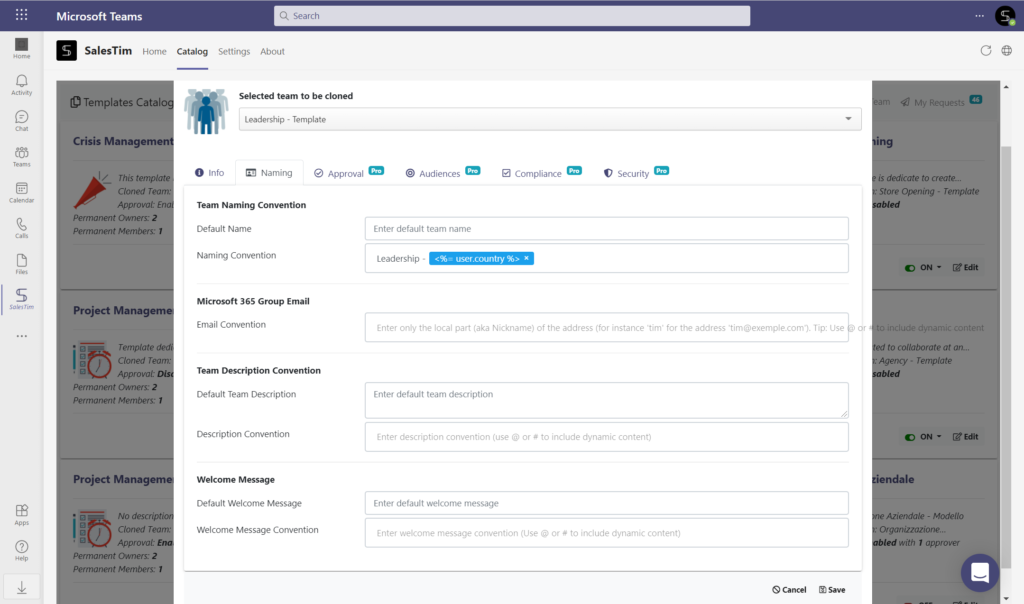
You may also want to make this template accessible only to your senior management. To do so, you can enable Audience targeting and specifying job titles for which the template will be available.
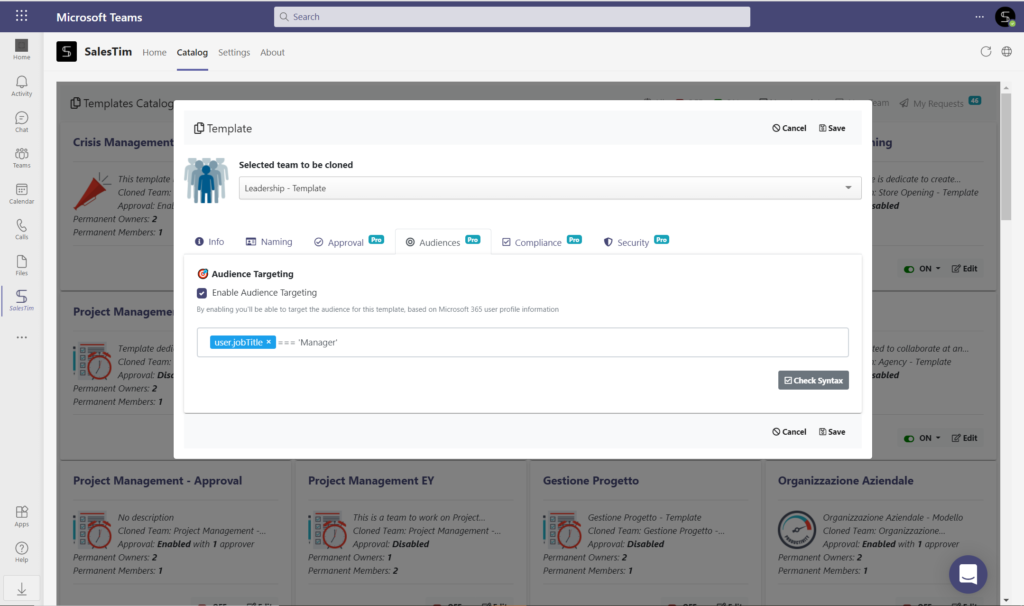
Additionally, you can add Permanent members so that the right people are always immediately added to leadership teams. For example, that can be your company’s CEO and other executives.
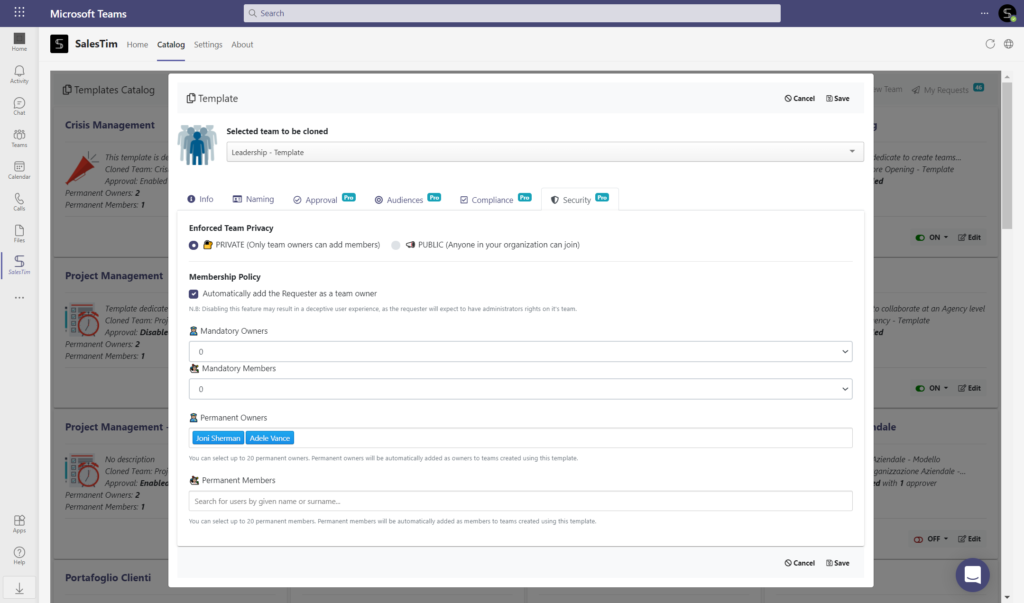
It’s also worth considering configuring sensitivity labels for your template to better protect the content of Leadership teams. You can do that by setting up the teams created from the template as confidential. This way, external users won’t be able to get guest access to these teams.
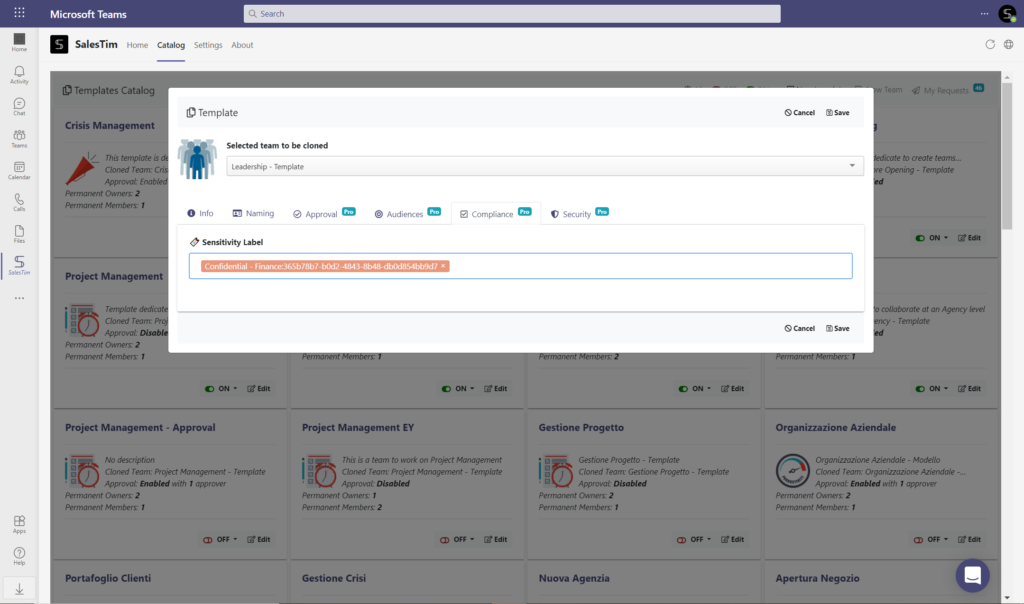
After configuring all the governance policies click on Save. Your template is ready!
Now your leaders can create Leadership teams for each business unit in just a few clicks.
All the content added to the template will be automatically added to new teams based on it.
If you’d like to learn more about how to implement Microsoft Teams collaboration templates in your organization, book a meeting with us and we’ll help you tailor templates for your specific use cases.
